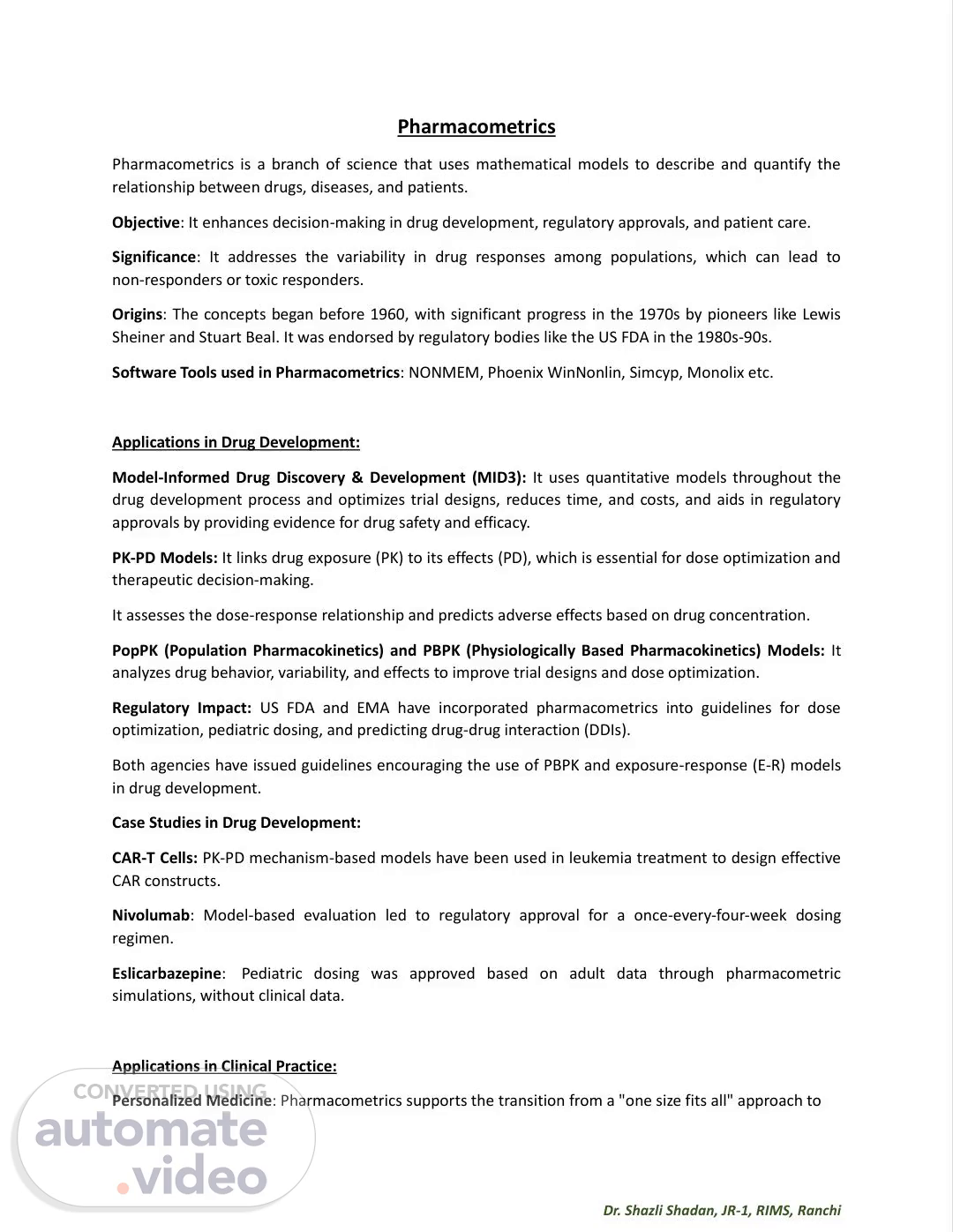Scene 1 (0s)
[Audio] Pharmacometrics Pharmacometrics is a branch of science that uses mathematical models to describe and quantify the relationship between drugs, diseases, and patients. Objective: It enhances decision-making in drug development, regulatory approvals, and patient care. Significance: It addresses the variability in drug responses among populations, which can lead to non-responders or toxic responders. Origins: The concepts began before 1960, with significant progress in the 1970s by pioneers like Lewis Sheiner and Stuart Beal. It was endorsed by regulatory bodies like the US FDA in the 1980s-90s. Software Tools used in Pharmacometrics: NONMEM, Phoenix WinNonlin, Simcyp, Monolix etc. Applications in Drug Development: Model-Informed Drug Discovery & Development (MID3): It uses quantitative models throughout the drug development process and optimizes trial designs, reduces time, and costs, and aids in regulatory approvals by providing evidence for drug safety and efficacy. PK-PD Models: It links drug exposure (PK) to its effects (PD), which is essential for dose optimization and therapeutic decision-making. It assesses the dose-response relationship and predicts adverse effects based on drug concentration. PopPK (Population Pharmacokinetics) and PBPK (Physiologically Based Pharmacokinetics) Models: It analyzes drug behavior, variability, and effects to improve trial designs and dose optimization. Regulatory Impact: US FDA and EMA have incorporated pharmacometrics into guidelines for dose optimization, pediatric dosing, and predicting drug-drug interaction (DDIs). Both agencies have issued guidelines encouraging the use of PBPK and exposure-response (E-R) models in drug development. Case Studies in Drug Development: CAR-T Cells: PK-PD mechanism-based models have been used in leukemia treatment to design effective CAR constructs. Nivolumab: Model-based evaluation led to regulatory approval for a once-every-four-week dosing regimen. Eslicarbazepine: Pediatric dosing was approved based on adult data through pharmacometric simulations, without clinical data. Applications in Clinical Practice: Personalized Medicine: Pharmacometrics supports the transition from a "one size fits all" approach to Dr. Shazli Shadan, JR-1, RIMS, Ranchi.
Scene 2 (2m 56s)
[Audio] tailored therapies based on patient-specific data. This allows for the optimization of drug dosage regimens, improving therapeutic outcomes and minimizing adverse effects. Bayesian Dosing: This method combines prior population data with individual patient data to refine dosing regimens. For example, Bayesian dosing has been used with Vancomycin and ADVATE® for Hemophilia A. Pharmacometric in Drug Interaction Studies: It predicts drug-drug interactions (DDIs) and guides necessary dosage adjustments. Example: Osimertinib, an anti-cancer drug, whose DDI profile was characterized using PBPK modeling, leading to safe dosage recommendations. Pharmacometric-Guided Dosing: Used in special populations (e.g., pregnancy, neonates, and cancer patients) to optimize therapeutic outcomes. Application in Oncology: Pharmacometrics aids in identifying predictive biomarkers and optimizing chemotherapy dosing. Example: Small Cell Lung Cancer (SCLC): PK-PD models predict disease progression and guide early therapeutic interventions. Gastrointestinal Stromal Tumors (GIST): Pharmacometric models assess tumor size and density, improving treatment outcomes. Examples of Clinical Applications: Tacrolimus in Renal Transplants: Bayesian dosing improved target concentration achievement. Quetiapine in Pregnancy: PBPK models suggested dose adjustments to maintain therapeutic levels. Neonatal Opioid Withdrawal: Pharmacometric modeling helped optimize buprenorphine dosing. Integration with Pharmacoeconomics: PK-PD-PE Models: Assess cost-effectiveness by linking pharmacological data with economic outcomes. Examples: Models for gout treatment and Rituximab in lymphoma patients. Challenges and Future Directions: Limited Clinical Use: Due to complexity of models, lack of awareness, and need for robust data. Educational Gaps: There is a need for broader education and training in pharmacometrics to increase its adoption in healthcare settings. REF: Article: Pharmacometrics: The science applied from bench to bedside Pharmacometrics: A New Era of Pharmacotherapy and Drug Development in Low- and Middle-Income Countries Dr. Shazli Shadan, JR-1, RIMS, Ranchi.
